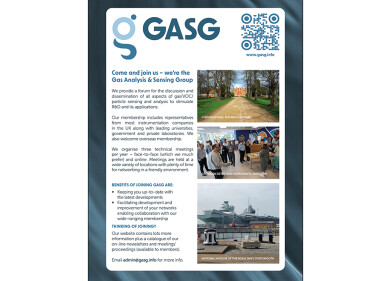Gas detection
An Introduction to Hydrogen Quality Assurance
Oct 19 2022
A Chartered Engineer and member of the Institution of Chemical Engineers, Dr. Arul Murugan heads up the energy gases area within the Gas Metrology Group at the National Physical Laboratory, producing research on a range of topics but with a particular emphasis on the study of hydrogen as an alternative fuel. In fact, Dr. Murugan recently produced a forty-minute introduction to hydrogen quality assurance, which you can watch over at the National Physical Laboratory’s YouTube channel.
Recently, EnvirotechOnline sat down with Dr. Murugan to learn more about the development of regulations for hydrogen quality assurance and to get his thoughts on what’s still needed for the future.
Firstly, could you tell us a little bit about your interest in hydrogen and why you decided to create this introduction?
Well, if you look at conventional cars which run on petrol, the combustion process can still operate quite well, even if there’s some impurities in the fuel. Whereas for a hydrogen fuel cell vehicle, the fuel cell contains a catalyst that can be really easily degraded by impurities. So, actually, hydrogen purity is much more important for hydrogen cars compared to petrol, so even if there’s four parts per billion of sulphur, which is a very small amount, that’s enough to destroy the fuel cell catalyst. Before hydrogen is dispensed from a fuelling station to the car, it’s really important that the fuel purity’s checked. But there are a lot of challenges with doing these measurements, it’s very difficult. My introductory video is there to provide guidance to laboratories and to hydrogen refuelling stations, to make sure they’re doing these measurements correctly and accurately.
Now, you mentioned some of them, but which professionals will need these skills of hydrogen quality assurance in the coming years?
Mainly, it’s the laboratories. What could happen, for example, is that a hydrogen sample is taken from the station, i.e. you take the hydrogen from the nozzle, it might go into a gas vessel and that’s transferred to a laboratory. It’s those laboratories that have the gas analysers that might need to do these measurements, but it’s also important for those working with hydrogen in stream generally to know about purity – the importance of purity – and they need to be able to access laboratories that are competent. I want industry – the people that are providing hydrogen – to know what sort of labs they should be going to. My introduction is also there to help them ensure that the labs they’re choosing are doing the right things, because they’re following the guidance that’s in the video.
And what will viewers learn if they watch your video?
It goes through about eight sections, the first of which is safety; if we’re working with hydrogen, it’s very important that safety is considered because hydrogen is flammable gas – you don’t want to cause an explosion, so I cover that first! Then, I talk about purity specifications; there are purity specifications for hydrogen going into a car or, you know, transportation, but there are also purity specifications for heat and industry, so I cover the other two topics a bit as well. Then, I talk about quality control, which is the idea of, for example, installing an on-line analyser at the station, so there's a bit of guidance on how to do a risk assessment, to understand what impurities are important. Then, I cover sampling, analysis methods, calibration, validation methods and proficiency testing. The last section covers, for example, how you might develop the evidence to show that you’re a competent provider of this analytical service.
Back in 2018, you co-ordinated the EMPIR’s Metrology for Hydrogen Vehicles project, the first large scale project of its kind aimed at tackling the four measurement challenges that, at that time, prevented the industry from meeting the requirements set by international standards. Could you tell us a little bit more about the project and what came of it?
Sure. At the time, the two biggest challenges were flow metering and gas quality, so the first work package was on flow metering and this is, again, the idea of if you’re dispensing hydrogen from the station into a car, you need to bill the customers, and to do that you need to know how much hydrogen has gone into the car. At the time there wasn’t any primary standard to calibrate those flow meters. So this project was aimed at developing the first primary standard to ensure that the flow metering measurements done at the station was accurate. So, that was one aspect.
The other three work packages were all linked to hydrogen purity. There was one work package on developing analytical methods for doing hydrogen purity in the laboratory, there was another on developing analysers that could be installed directly at the station to continuously monitor impurities, and then the final work package was on sampling which is very important as well because if you take a sample of hydrogen from the station, and you’ve done it wrong, say for example you’ve added air to the samples, or youre using a vessel that removes the impurities to the wall, you’re not going to have a representative sample when it arrives at the lab.
So, we developed good practice and guidance on sampling as well as part of that project. So that was done over three years and I think the biggest outcomes really were the development of new methods, primary reference materials and also the good practice guidance which has gone directly into ISO standards, so theyre used worldwide.
At the moment, in 2022, what would you say is the main challenge facing hydrogen metrology?
So, there was a follow-up project with EMPIR, Metrology for hydrogen vehicles 2, and that’s being coordinated by my colleague at NPL, Dr. Thomas Bacquart, and I think the gas quality problems are still there, so we’re continuing the work by looking at more complicated impurities and more reactive impurities. On the flow metering side, what we’ve noticed is that there’s been a push from hydrogen being used for passenger vehicles to hydrogen being used for larger vehicles, like heavy goods vehicles, trains – so what we need to develop there is a new type of flow metering primary standard that is suitable for doing flow metering measurements for bigger transport. The new project also includes some work on fuel cell testing, as well, so developing capabilities so that we can test how different impurities or different qualities of hydrogen actually affect the fuel cell, so that we can understand that process a bit more.
Lastly, what do you think the future for hydrogen quality assurance might be?
I think we have a really good understanding of hydrogen quality at the moment, there’s an ISO Standard, ISO 14687, this was developed about a decade ago in 2012. That standard’s at a pretty good stage at the moment, but what will happen is if for example the fuel cell manufacturers decide to reduce the catalyst loading on the fuel cells, we might need to change the standard a bit. As we understand how impurities affect fuel cells more, because we’re doing more research, we may need to change the ISO standard a bit so the impurity specifications might change slightly – but it probably won’t change too much, if we do.
For the industry, as hydrogen becomes widely used, so more hydrogen fuelling stations, more transport using it, I think what we’ll find is that more laboratories will become established to do these kind of measurements. So, a bigger thing for NPL will be that we might need to step back from doing hydrogen purity but start providing a lot of primary reference materials and proficiency testing to support these laboratories to do all these testing themselves but to do it accurately and traceably.
Head on over to NPL’s YouTube channel to look at the introduction to hydrogen quality assurance.
Digital Edition
AET 28.4 Oct/Nov 2024
November 2024
Gas Detection - Go from lagging to leading: why investment in gas detection makes sense Air Monitoring - Swirl and vortex meters will aid green hydrogen production - Beyond the Stack: Emi...
View all digital editions
Events
Jan 12 2025 Abu Dhabi, UAE
Jan 14 2025 Abu Dhabi, UAE
Jan 20 2025 San Diego, CA, USA
Carrefour des Gestions Locales de L'eau
Jan 22 2025 Rennes, France
Safety, Health & Wellbeing LIVE
Jan 22 2025 Manchester, UK




















